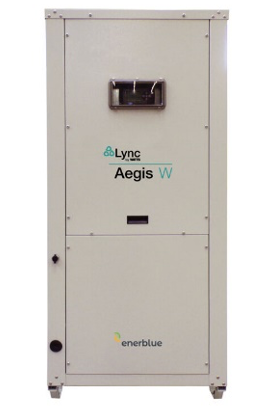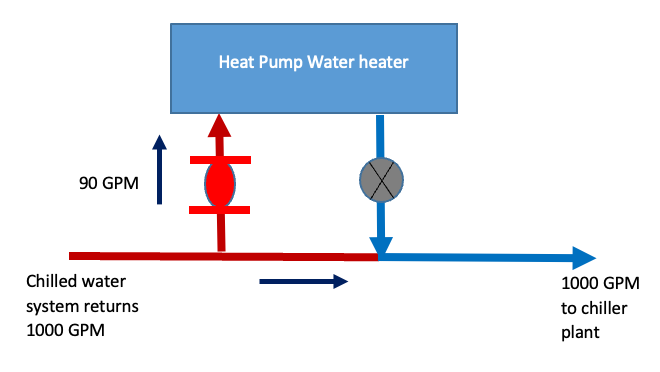 Many heat pumps used in Ohio and Michigan are water source for comfort heating and cooling. Today, we want to look at the opportunity to use chilled water as the heat pump water heater source. We will look at the Aegis W from Lync® by Watts as well as a modification to the Aegis A air source water heater discussed in the last several R. L. Deppmann Monday Morning Minutes.
Many heat pumps used in Ohio and Michigan are water source for comfort heating and cooling. Today, we want to look at the opportunity to use chilled water as the heat pump water heater source. We will look at the Aegis W from Lync® by Watts as well as a modification to the Aegis A air source water heater discussed in the last several R. L. Deppmann Monday Morning Minutes.
Chilled Water as the Heat Source
Last week’s blog introduced the water source heat pump water heater including a capacity chart. We saw, in the example model, an impressive 550 MBH output to the domestic water system when supplied with 55⁰F water and a 9⁰F source temperature difference. The same blog showed a typical COP chart which indicated approximately 4.0 COP when supplied with 55⁰F water.
If you have chilled water system operating all year round this can be an attractive fit. Imagine a data center with a cooling requirement all year long. The engineer could design a one pipe primary loop on the return to the chiller plant. The system would take about 90 GPM of return water and use the heat for the Aegis W heat pump water heater. The water would return to the chilled water system at about 46⁰F. The electrical use for this would be about ¼ of that of electric resistance water heaters. This is a real bonus for the owner who is already using a great deal of electricity in the data center.
An Ideal System to Save the Planet
In addition to the significant use of electricity to create the hot water, we are dropping the load on the chiller system. Now you are not only reducing the electrical use on the water heater side, but you are also now getting paid to make the hot water.
I can imagine a large data center with an apartment building next to it. I could even imagine a process plant that needed hot water on a regular basis. This could be a groundbreaking article in the ASHRAE Journal.
Unfortunately, there are few systems in Michigan and Ohio that have a constant chilled water load in the winter months. Lync by Watts did think about that.
Air Source Heat Pump Water Heater with a Water Source Option
Lync by Watts recognized there are times when a water source is available for the Aegis heat pump water heater. They also understand that there may not be water available all the time. The Aegis Cool Recovery Option is available on the air source units.
The cool recovery option will operate the heat pump in air source mode when the water source is not available, or when the water source is at a target temperature and there is still a demand for hot water. When the water source is available, the air side shuts down and the water source is used. For example, an office building with a central chilled water plant that cools the building from May through September but shuts the cooling plant down in October. This way the building can realize savings on the cooling plant in the summer but continue to operate as an air source unit in the winter.
Example System Savings
Look at some rough numbers as an example. The ASHRAE Applications handbook chapter 50 has a table 7 showing average daily water use in apartment buildings. The “medium” usage is an average of 30 gallons of 120⁰F water per person per day. In previous R. L. Deppmann Monday Morning Minutes in this series, we used an example of an apartment building with 210 people. We use chilled water in the cool recovery section for 5 months per year and the outdoor air for the other 7 months. The net electrical use becomes a negative number. This means that the domestic hot water will use no net electricity and we will even save on the chilled water side.
There is a representation of this system shown at the beginning of this blog. In our northern climates there will be discussion about the chilled water pipes shown exposed to the elements. If the system is operating in the winter, it most likely has Dowfrost™ or Dowtherm™ glycol mixtures in the system. If the system is not operating in the winter, it may be drained, or heat traced.
This option will reduce the overall cost of ownership for this carbon-reducing option. R. L. Deppmann can collaborate closely with the engineers in our territories to address the details for an efficient and trouble-free design of the system.
Part 1: Heat Pump Water Heaters: The Road to Decarbonization
Part 2: Heat Pump Water Heaters: How They Work
Part 3: Heat Pump Water Heaters: Refrigerants and Weather
Part 4: Heat Pump Water Heaters: Temperatures & Storage
Part 5: Heat Pump Water Heaters: Parts & Pieces & Storage
Part 6: Heat Pump Water Heaters: Hot Water Recirculation
Part 7: Heat Pump Water Heaters: Standby Capacity
Part 8: Heat Pump Water Heaters: Capacity, COP, and Weather
Part 9: Heat Pump Water Heaters: Example Apartment Building
Part 10: Heat Pump Water Heaters: Example Apartment Building Costs
Part 11: Heat Pump Water Heaters: Drive Down First Cost Using Hybrid Solutions
Part 12: Heat Pump Water Heaters: Water Source Units
™ Trademark of Dow or an affiliated company of Dow



